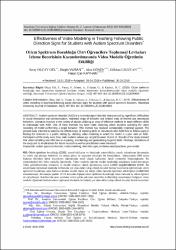Effectiveness of Video Modeling in Teaching Following Public Direction Signs for Students with Autism Spectrum Disorders
Abstract
Autism spectrum disorder (ASD) is a neurobiological disorder characterized by significant difficulties in social interaction and communication, restricted range of behavior and limited areas of interest and stereotypic behaviors. Literature involves a rich variety of studies utilizing an array of effective methods to teach different skills to individuals with ASD. One of these methods has been video modeling which involves watching the video recording of model performing a target behavior. This method has received considerably empirical support. The present study intended to examine the effectiveness of teaching skills to individuals with ASD how to follow signs in finding the restroom in a public setting by utilizing video modeling in which the model is a peer with an ASD. Participants of the study were three male students whose age ranged between 10 and 13. Results of the study showed that video modeling was effective in acquiring, maintaining and generalizing targeted skills. Findings, limitations of the study and its implications for future research as well as practitioners were discussed.
Source
Hacettepe Universitesi Eğitim Fakültesi Dergisi-Hacettepe University Journal of EducationVolume
34Issue
2Collections
- Makale Koleksiyonu [156]
- Scopus İndeksli Yayınlar Koleksiyonu [8325]
- WoS İndeksli Yayınlar Koleksiyonu [7605]


















